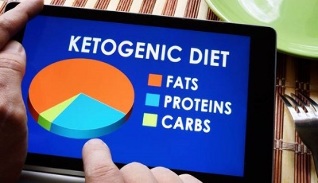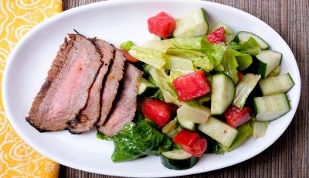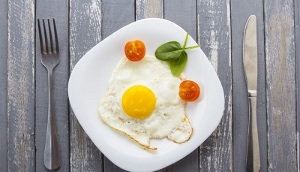
Lack of hunger, clear mind, and rapid loss of excess weight are all benefits of a ketogenic diet. Find out what a keto diet is and choose the one that suits you best!
The ketogenic diet is no longer a newbie in the field of nutrition and weight loss, but it is still the most controversial method. All this is due to its champions: on fried chicken legs and juicy cutlets, you can not only lose weight, but you never gain weight. The doctor warns: Keto diet is difficult, dangerous, not fully understood, and full of many side effects.Fat diet comes from the medical profession. For a long time, fat diet has been used to reduce epileptic seizures in children. It is one of the varieties of low carbohydrate nutrition plan. However, the main difference between the ketogenic system and the usual ketogenic system is that fat is the main nutrient in their diet.
Working principle
In the usual proper nutrition, the most beneficial nutrient ratio (BZHU) is 1: 1: 4, which means that carbohydrates are the basis of diet. They are the main source of energy (calories) and an essential source of glucose in the nervous system. However, a large number of studies have confirmed that this is not entirely correct. Swedish scientists have shown that the human body will switch to another "mode" due to the increase of fat and protein, and the rejection of sugar after its own glycogen storage is exhausted. Habitual metabolism is rebuilt, and glucose is no longer the main source of energy. The liver produces a special form of acetone, called ketones (ketone bodies), which move with the bloodstream and affect the oxidation of fatty acids. As a result, our body enters a state of ketosis, not from the carbohydrate chain but from the fat processing products to extract energy, first consume subcutaneous fat, and then use the fat in the food. Scientists’ experiments have confirmed that ketones are a more important physiological fuel for the brain, while sugars are cheap and fast energy that will cause degenerative encephalopathy in the future.
After obtaining overwhelming research results, professional athletes and bodybuilders became interested in this method. The ketogenic diet became popular and changed from a diet to a lifestyle that is expected to lose weight quickly, strengthen and increase muscle mass, without persistent hunger, and thus change lives.
However, despite its effectiveness, doctors warn that the ketogenic diet is related to the calculation of nutritional norms and is therefore prescribed and monitored by a nutritionist. Proper startup, maintenance and control of ketosis are very important. Writing your own menu program means taking a big health risk!
Main view
Professional athletes distinguish three main types of ketogenic diets:
Standard (SKD-standard ketogenic diet)

This is a basic linear program with medium to high protein intake, high fat and low sugar intake. It is characterized by a continuous supply of ketogenic nutrients without the need for regular glucose supplementation. SKD is very suitable for people with little activity (an addicted lifestyle, irregular exercise).
How to calculate the nutritional balance? For example, for a person weighing 75 kg and exercising 2-3 times a week, adopt a standard ketogenic diet.
- First, let us calculate the daily calorie intake (KRday). For our example, this is approximately 2000 kcal/day.
- The amount of protein (Bsut) required is 2 grams per kilogram of weight, that is, in our example, Bsut = 2 * 75 = 150 grams/day.
- The daily carbohydrate content (Usut) is 0. 2-0. 4g. For every 1 kg of body weight, that is 15 to 30 grams per day (we will use 30 grams as the standard for calculation).
- Let us calculate how many calories in our daily diet come from protein and glycosides. It is known that each nutrient contains 4 calories per gram. Therefore, in our calculation, the value is (150 + 30) * 4 = 720 kcal.
- As you can see, for our example, a person should get 1280 kcal (2000-720) from fat. And since 1 gram of fat contains 9 calories, the daily fat mass (F/day) = 1280/9 = 142 grams.
Through calculations, we determined that in this case, the diet should consist of 150 grams of protein, 30 grams of carbohydrates, and 142 grams of fat, divided equally between meals.
Cycle (CKD-cyclic ketogenic diet)
Provides an option for experienced bodybuilders who can make their body feel good and understand proper nutrition, calories and dietary rules. CKD is suitable for athletes who train every day and report the decline in training effect in the context of the basic system and the target system. The goal of this method is to determine the correct time interval (replenishment) between two carbohydrate loads, and to calculate the amount of glucose that allows you to work on your body at maximum intensity.

Bodybuilders recommend gradually introducing replenishment, starting from once a week, and adjusting the time interval between two loads according to personal needs to monitor your health. Write down how many carbohydrates you consume every day and how you feel in general.
The main rule of loading day: W/day indicator decreases, while B/day should remain the same (or increase). U/day depends on the individual’s sensitivity to insulin. The low dose is 2-3 grams per 1 kg, the normal dose is 4-5 grams per 1 kg, and the normal dose is 6-7 grams per 1 kg.
In our example, let us calculate the caloric intake of CDC under normal insulin sensitivity.
- B/day = 2 * 75 = 150 grams/day.
- Y/day = 450 to 525 grams/day.
- The daily calorie content of protein and sugar on the day of carbohydrate load is (150 + 450) * 4 = 2400 kcal.
- As in the previous calculation, we calculate the remaining calories and divide the result by 9 to get how many grams of fat should be included in the carbohydrate-day diet.
Therefore, the calculation results show that the menu will be constructed as in CKD in 6 days of CKD, and the calorie content of one day (carbohydrate) is 2500 kcal (150 g protein, 300 g carbohydrate and 78 g fat)
TKD target ketogenic diet
Suitable for athletes who exercise for a long time. If there is no glycoside after taking these exercises for a long time, their performance will drop sharply and they can benefit from low carbohydrate intake. It is characterized by short-term sugar injections during the so-called “training window” (ie, before and after training), which will increase endurance but will not inhibit the progression of ketosis. The purpose of targeted ketogenic nutrition is to provide short-term improvements in performance and endurance. If there is no training, the SKD indicator will be used.
For our example, let us calculate Y/day before and after training:

- B/day = 2 * 75 = 150 grams/day.
- The increase in Y/day depends on insulin resistance, low sensitivity is +0. 5 g per 1 kg, normal sensitivity is + 0. 75 g per 1 kg, and high sensitivity is +1 g per 1 kg weight. It is recommended to divide these extra carbohydrates into two equal parts and eat them before and after training.
- Same as the previous calculation, subtract the daily calories of protein and carbohydrates from the total calories of the diet. The resulting increase will be calories from fat.
Attention!This calculation is not a rule, but an example. The calculation of the basic menu indicators should be based on individual characteristics, and the fine-tuning of the supplement for the target and periodic ketogenic diet can only be repeated based on health, performance indicators, endurance, intensity and the length of the training period. If you are not sure about your abilities and experience, we suggest you contact a nutritionist.
Rules
To achieve the desired weight loss results, please follow these guidelines:
- First fast for one day. Only water is allowed.
- The diet should include: the "right" fat-60% protein, 30% protein, and at least 10% carbohydrates per daily calorie intake.
- Mandatory intake of vitamins and minerals (calcium, vitamin D, folic acid).
- Drink as much as possible.
- Eat food from the allowed list.
Allowed and prohibited products
Promote the onset and maintenance of ketosis by the following methods:
- High-fat fermented dairy products (including cheese);
- lard, fat, poultry with skin;
- Sausage (ham, balic, poached pork);
- Fish (fat is preferred) and seafood;
- Hard cheese (try to choose the cheese with the lowest carbohydrate content);
- Avocado;
- Oil (butter, unrefined vegetable oil, coconut oil);
- Mushroom;
- Vegetables rich in fiber;
- Banana;
- Nuts, nut butter;
- Pumpkin seeds;
- Green leaf salad.
Minimum allowed value:
- Dark bitter chocolate with the highest cocoa content and the lowest sugar content;
- Roots, vegetables, fruits without heat treatment;
- Tea, coffee.
Prohibited products:
- carbonated drinks;
- Sugar, honey;
- Baked goods, bread;
- Cereal;
- Dried fruits;
- Skim milk, kefir, yogurt; Margarine, spread;
- Pasta;
- Starchy vegetables.
Menu

When designing a one-week menu for a ketogenic diet, nutrition experts recommend not to focus on the weight of the food, but to make the menu based on the volume of the food and calculate the BJU ratio.
A ketogenic menu for about a week, and suggestions were considered.
Monday
- Breakfast: scrambled eggs from 2 eggs; hard cheese bacon; a cup of coffee.
- Lunch: vegetable salad seasoned with mayonnaise ("Iceberg" + cucumber + celery leaves); fried chicken skin with hard cheese.
- Dinner: steak; broccoli stewed mushrooms; coffee with cream.
Tuesday
- Breakfast: cutlet; hard cheese, cup of American coffee and milk.
- Lunch: salmon steak with cream sauce; steamed broccoli lettuce salad with cheese and eggs, mayonnaise.
- Dinner: pork chops; stewed cabbage and vegetable salad; tea.
Wednesday
- Breakfast: 6-egg omelet, topped with grated cheese (you can use a protein shake instead); soy milk-0. 5 liters
- Lunch: smoked beef bri; zucchini fried with cheese.
- Dinner: red fish with cream sauce; vegetable salad with mayonnaise; yogurt.
Thursday
- Breakfast: boiled eggs-4-5 slices; any seasoning-2-3 tablespoons. Spoon of vegetable salad with cheese.
- Lunch: Mushrooms stewed in sour cream; spinach salad; fried fish.
- Dinner: meat steak; honey toast milk.
Friday
- Breakfast: scrambled eggs (3-4 eggs); high-protein drinks; hard cheese.
- Lunch: scrambled eggs; fried chicken breast with hard cheese.
- Dinner: salmon; unroasted almonds; salad.
Saturday
- Breakfast: salmon; grapefruit; salad.
- Lunch: fish; vegetable stew with nut mix.
- Dinner: vegetable salad; a few sausages; cheese.
Sunday
- Breakfast: eggs in a bag; cheese; vegetable salad.
- Lunch: turkey; tomato salad with mayonnaise; cheese.
- Dinner: cheese. Grapefruit.
Make sure to follow your drinking habits. Drink at least 1. 5 liters of water throughout the day.
Contraindications and side effects
A few days after starting the ketogenic diet, you may feel weak, lethargic and depressed. This kind of nutrition is not natural, so it is particularly dangerous for growing organisms. For teenagers, the use of this food is absolutely prohibited. If a long-term or inappropriate ketogenic diet is used, the following side effects may occur:
- Urolithiasis;
- The level of bad cholesterol in the blood increases;
- Violation of peristalsis, gastrointestinal functional status (gastroesophageal reflux);
- Dehydration (because carbohydrates remove excess water); Due to lack of protein,
- developmental delay (adolescent);
- Vitamin deficiency;
- lack of minerals, which leads to mineral remineralization and osteoporosis;
- Inflammation of the pancreas (pancreatitis); Hormonal imbalance and menstrual cycle failure;
- Ketoacidosis.
This is why in order to avoid the development of pathological diseases and the deterioration of existing diseases, diet should be controlled by specialists. When losing weight, it is recommended to monitor your condition every month and perform basic tests (blood, urine). The correction or cancellation of the ketogenic diet is carried out by the doctor based on the examination results.




























